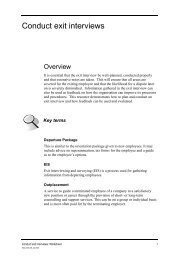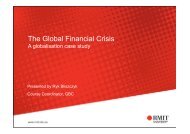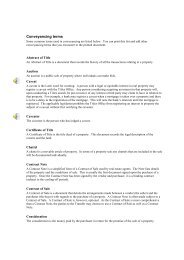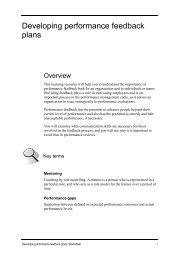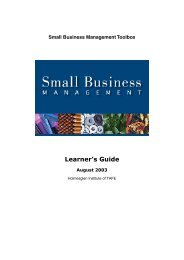Promoting deep learning - RMIT University
Promoting deep learning - RMIT University
Promoting deep learning - RMIT University
- No tags were found...
You also want an ePaper? Increase the reach of your titles
YUMPU automatically turns print PDFs into web optimized ePapers that Google loves.
Transnational TeachingQuick GuideTeaching practice - <strong>Promoting</strong> <strong>deep</strong> <strong>learning</strong>Deep & surface <strong>learning</strong>A little <strong>learning</strong>is a dangerous thing.Alexander PopeMarton and Saljo (1976) examined <strong>learning</strong> patterns of students and identifiedtwo key approaches: <strong>deep</strong> and surface <strong>learning</strong>. Deep <strong>learning</strong> is the typeof <strong>learning</strong> that sees students reflecting on their <strong>learning</strong>, applying it to reallife experiences, making connections and analysing and evaluating concepts.Surface <strong>learning</strong> is related to rote <strong>learning</strong>, which suggests memorizingfacts for exams and passively receiving information. Surface learners do notnecessarily relate new knowledge to real life.It is acknowledged that learners use both types of <strong>learning</strong>. Learners shouldnot necessarily be categorized in one group or the other:“Deep and surface <strong>learning</strong> approaches are used by students dependingon their perception of the task being completed. Students may, in fact,swap from one approach to another according to the demands of thetask.” (Wee, Sep 8 2010).<strong>RMIT</strong> <strong>University</strong> promotes engaging students in <strong>deep</strong> <strong>learning</strong>. Your role asa teacher is to guide students through meaningful <strong>learning</strong> experiences thatenhance their professional lives.As a transnational teacher, you must consider how you might develop studentsas <strong>deep</strong> learners.Strategies to develop <strong>deep</strong> <strong>learning</strong>There are a number of strategies academic and teaching staff can adopt todevelop <strong>deep</strong> learners:• Actively involving students in their <strong>learning</strong> and assessment and allowingthem to make choices and provide input. Consider how you could allowstudents to make choices about <strong>learning</strong> and assessment activities so thatthe activity is more relevant to them.• Engaging students through structured activities that are relevant to thecourse and are localised to take into account issues and problems thatare real and meaningful. It is important to ensure students understandthe holistic nature of what they are <strong>learning</strong> and how it fits into the bigpicture. Where possible use actual and contextualised cases and examplesso students can see the relevance of the subject matter.• Engaging students in reflection and reflective writing that personalisestheir <strong>learning</strong>. You could ask students to keep a blog or journal on their<strong>learning</strong> journey so that they are able to reflect on how they changedover time. This is particularly useful when they take part in group1 © 2014
activities as you can see how each student has synthesised the <strong>learning</strong>experience.• Providing a supportive environment where students are not fearfulof making mistakes and where they learn from their peers as well asfrom you. One of the most important requirements of teaching is toconstruct a safe <strong>learning</strong> environment where students are happy to takerisks in their <strong>learning</strong>. Students may quickly lose motivation if they fearembarrassment or punishment.• Demonstrating a passion for the subject and encouraging students to dothe same.• Designing integrated assessments which allow students to bring togetherkey concepts from different subject areas or areas of interest.• If you are involved in the design of assessment activities, design tasks thatencourage students to solve problems and to integrate new knowledgeusing existing knowledge. Find ways to assist students put the newknowledge into context. Wee (2010) suggests that students should havethe opportunity for group involvement, discussion, and reflection withtheir peers for assessment purposes.Supporting transnational studentsCultural differences amongst students must be accommodated. You can assiststudents who might be more familiar with surface <strong>learning</strong> to transition to<strong>deep</strong> <strong>learning</strong> by:• Creating a supportive environment and allowing time for students toadapt to <strong>deep</strong> <strong>learning</strong> activities.• Introducing reflective writing with support from academics and teacherand fellow students.• Using group <strong>learning</strong> rather than individual competition in <strong>learning</strong> tasks.What actually enhances <strong>deep</strong> <strong>learning</strong>?Research and practice indicates that the required elements to enhance <strong>deep</strong><strong>learning</strong> include:• Active student involvement in course concepts and ideas• Interest in the subject by both students and teachers• Possession of sound background knowledge and skills• Ability to make connections and links• Ability to reflect on one’s own <strong>learning</strong>• Well constructed and thought provoking assessment tasks• Reflective analysis of <strong>learning</strong> and assessments• Positive and supportive <strong>learning</strong> environments which allow students toexplore new concepts and new knowledge without fear of failure.2 © © 2014
Useful resourcesSupport is available from your Deputy Head of School (Learning & Teaching) orequivalent. Your College Academic Development Group or <strong>learning</strong> & teachingspecialist can also provide advice, support and professional development.<strong>RMIT</strong> <strong>University</strong>’s Practical Guide to Teaching will help your plan and improveyour teaching practice:http://www.rmit.edu.au/teaching/practicalBaeten, M, Kyndt, E, Struyven, K & Dochy, F 2010, ‘Using student-centred<strong>learning</strong> environments to stimulate <strong>deep</strong> approaches to <strong>learning</strong>: factorsencouraging or discouraging their effectiveness’, Press Educational ResearchReview 2010.http://dx.doi.org/10.1016/j.edurev.2010.06.001Getting Smart Blog Series - Leading for Deeper Learning: 10 Proven Strategieshttp://gettingsmart.com/2013/08/leading-for-<strong>deep</strong>er-<strong>learning</strong>-10-provenstrategies/Phelps, R & Ellis, A 2003, ‘From page turning to <strong>deep</strong> <strong>learning</strong>: a case history offour years of continual development of an ICT course’, in G Crisp, D Thiele,I Scholten, S Barker & J Baron (eds), Interact, integrate, impact: proceedings ofthe 20th Annual Conference of the Australasian Society for Computers in Learningin Tertiary Education, Adelaide, SA, 7-10 December, Australasian Society forComputers in Learning in Tertiary Education, Wollongong, NSW, pp. 407-414.http://epubs.scu.edu.au/cgi/viewcontent.cgi?article=1004&context=educ_pubs3 © © 2014





